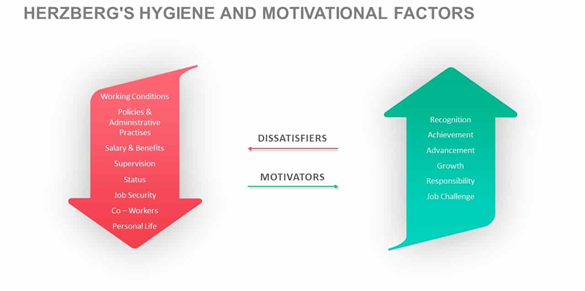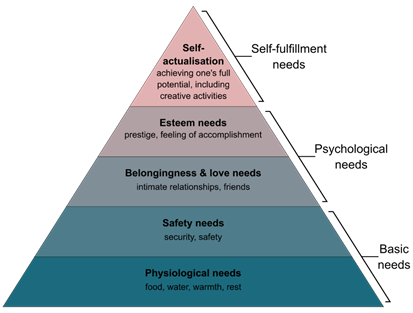This Week in HR, with empact HR

If Your Employees Dread Walking Through the Front Door, Do This (an extension of Last Week in HR)
Last week in HR, we discussed various motivation and engagement theories. I gave an overview of several of the most prominent ones in Human Resource studies. This week in HR, we welcomed some benefits experts from USI to our podcast, Down the HR Rabbit Hole. We discussed Wellness programs and how they can strategically enhance employee engagement by checking off employee needs. I started thinking – distractedly as I do but without derailing the podcast – about the obvious philosophical similarities between modern benefits brokers’ sales pitch and Abraham Maslow & Frederick Herzberg’s motivation theories. In short, employees’ basic needs must be met for them to reach their best potential.
Michelle Parker, the Population Health Manager for USI, mentioned a scenario where working parents can’t possibly work at their penultimate level if they are not assured that their families are protected and covered should health problems arise. Informed by big data, Michelle and her team, augment the benefits and wellness decision-making process, which can be very complicated, to strategically enhance their clients’ bottom lines. Motivation and the conditions that foster or inhibit it directly correlate to productivity and efficiency.
It helps to have a basic understanding of motivation when you consider and implement management tactics and strategies. Strategies can vary by whatever perspectives or theories leaders ascribe to motivation and how that is cascaded down and incorporated into practices, policies, and culture, but at the end of the day, there are many universalities across the spectrum of employee motivation theories that bring to bear on strategies.
The effectiveness of these approaches is further determined by whether individual preferences for methods of motivation are considered.

You may recall from the previous post that Herzberg’s Two-Factor Theory implies that for the happiest and most productive workforce, companies need to work on improving both motivator and hygiene factors. The theory suggests that to help motivate employees, the organization must assure everyone feels appreciated and supported (Communication & Leadership Style), is given plenty of specific and meaningful feedback (Communication), and has understanding and confidence in how he or she can grow and progress professionally (Communication & Professional Development). In this framework, employers should be concerned with and address both motivators and dissatisfiers; to fix one is not to fix the other, but there is symbiosis if altogether addressed.
To prevent job dissatisfaction, companies must make sure to address the hygiene factors by offering employees the best possible working conditions and fair pay that includes forming supportive relationships with them. In Herzberg’s framework, we can look at benefits, rather poor or absent benefits as major sources of dissatisfaction, related to Personal Life, and working conditions, too. And in these cases, addressing motivators will have little to no positive impact on the employee’s motivation; you have to have both conditions appropriately calibrated to see positive results.
Further, true engagement occurs in companies when remove issues that cause dissatisfaction – the baseline benefits offered by the company that satisfy the hygiene needs of the employee. Then you must focus on the individual and what they want out of their association with your enterprise.
Maslow’s Hierarchy of Needs pyramid, on the other hand, can be used to transform a business where managers struggle with the abstract concept of self-actualization and tend to focus too much on lower-level needs instead.
Self Actualization in the workplace looks like employees who are in jobs they love to do, that they’re good at, sufficiently challenged daily, and appropriately paired with a manager that understands their needs. Don't underestimate the synergies you could achieve with these employees.
 You could test the fitness of Maslow’s model in your workplace by creating affinity groups, or committees to focus on specific business problems. Be careful, though, not to create subgroups that further broaden diversity gaps, in other words, I like to encourage employers to help employees with similar interests and skills, not similar physiologies, to coalesce when possible. Not to discount the importance of being around people you’re comfortable with, but there is real value in helping employees find common, essential threads that transcend certain fleshly similarities—this is the beginning of authentic inclusion and belonging as Maslow would have put it.
You could test the fitness of Maslow’s model in your workplace by creating affinity groups, or committees to focus on specific business problems. Be careful, though, not to create subgroups that further broaden diversity gaps, in other words, I like to encourage employers to help employees with similar interests and skills, not similar physiologies, to coalesce when possible. Not to discount the importance of being around people you’re comfortable with, but there is real value in helping employees find common, essential threads that transcend certain fleshly similarities—this is the beginning of authentic inclusion and belonging as Maslow would have put it.
You should also notice that physical and safety needs are prerequisite for meeting the higher-level needs. Things like benefits, again, come into play in these foundational bricks. Better yet, if we’re testing theories here, consider a focus group on health and wellness. People need a deep sense of meaning or purpose—employees are pleased to contribute.
Sometimes, employees need to see the value of their roles. That enables employees to feel respected and motivated to work. If you really hit it out of the park, you may even help to achieve broad self-actualization, which always pays off for employers.